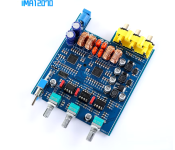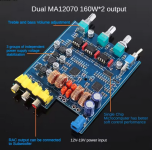I see in the spec that the input filter can be bypassed. Not a good idea. Totally agree with HF noise is a problem if not dealt with.
But i think this chip has dealt with it also for unballanced signal.
Maybe if it was a -100dB thd+n amp it would have been measureable in the audio bandwith also
But i think this chip has dealt with it also for unballanced signal.
Maybe if it was a -100dB thd+n amp it would have been measureable in the audio bandwith also
A balanced signal has other benefits like hum an other common mode problems that is suppressed by the chip -90dB CMRR
But I did not have those proplems in my single ended setup compared to the noise and thd of the chip itself
But I did not have those proplems in my single ended setup compared to the noise and thd of the chip itself
By the way. I use a single ended version of this amp right now for my 12 inch bass in my hybrid active passive 3 way speaker.
Not disco levels but loud enough for everyday use
Not disco levels but loud enough for everyday use
You seem to miss that the chip itself is the main EMI creator at its outputs. Whether it chokes on its own generated EMI fed back via input/input opamp or via its supply lines (more likely) is irrelevant, the problem occurs at it outputs and should be filtered. The manufacturer recommends both output filtering and supply line filtering for a reason.But why. The chip is balancing the signal on the input side. Why is that creating EMI?
Last edited:
Nicely done.Done. Now bats can live in comfort and a neighbor with laboratory EMI measuring equipment will be at ease 😎
Ferrites BLE32PN300SN1L, caps Yageo 1000pF C0G
30 ohms at 100MHz could possibly make the ferrite beads run hot, depending on the switching frequency, speakers used, the length/type of speaker cables...
You can test this without the input signal. Just don't burn the fingers... in case they are hot.
I use this amp at 5-15W levels and this partnumber of beads is recommended by Infineon in tech docs...30 ohms at 100MHz could possibly make the ferrite beads run hot
Yes, filter on inputs and outputs. Is there any data on the EMI or is it just discussions.
I really have difficulty to see how emi is affected by balancing inside or outside the chip itself.
I really have difficulty to see how emi is affected by balancing inside or outside the chip itself.
C. Almighty! MA12070 itself is the EMI transmitter as it is a switching IC with speaker cabling as antennas. That is also why many ceramic decoupling caps are needed and outputs and power line need a filter. Do you read anything at all about the IC? Repeatedly I tried to get irrelevant bal/unbal discussion out of the equation as it can be EMI straying in on opamps in preamp section, power line, its own internal components, its 5V regulator etc. Whatever. Solving problems at the root seems most effective so not letting the EMI get out and prevent straying in on its supply line.
It is practically 100% for sure its own EMI as the output filtering Anatolii_A soldered in solved the problems. PA3S is known for this. I take an educated guess that it also does not have PSU line filtering besides the already lacking output filtering. In short: in original unmodified form it sucks. Even El Cheapo BRZHiFi has filtering.
RTFM: https://www.infineon.com/dgdl/Infin...N.pdf?fileId=5546d46264a8de7e0164b359d78016f6
It is practically 100% for sure its own EMI as the output filtering Anatolii_A soldered in solved the problems. PA3S is known for this. I take an educated guess that it also does not have PSU line filtering besides the already lacking output filtering. In short: in original unmodified form it sucks. Even El Cheapo BRZHiFi has filtering.
RTFM: https://www.infineon.com/dgdl/Infin...N.pdf?fileId=5546d46264a8de7e0164b359d78016f6
Last edited:
That`s funny. Source of those EMI measurements is a IPad into a coax cable. So unbalanced input on ma12070
I run one Pa3s at my desktop balanced input, short speaker wires.I hadn't really been following along with the PA3S discussion. So it comes with no filtering at all? That's a really dumb design decision for an amp with external speaker terminals. Could maybe get away with it in a powered speaker with very short wires.
Sound is excellent!
Hello everyone! I read this forum thread. I am very interested in buying an amplifier on this chip. The board shown in the photo has the so-called MСU chip, if I understand correctly it is responsible for changing the volume in digital form and possibly for other controls such as changing high and low frequencies, etc. I wonder, what do you guys think, does this MСU chip already transfer the amplifier to PMP2 mode? I will be glad to any information, since I do not know which board or ready-made amplifier on MA12070 should I choose! Thank you in advance for your answers!Btw I measured this design. Lost of filtrering going on and decent quality on caps and coil
View attachment 1375160
Attachments
I'd guess the audio flows through the three 8 pin chips on the red sockets. That's why they're conveniently provided with sockets, so they can be "rolled" for different, "better" devices which is an audiophile advantage and selling point. I'd guess its these devices doing any pre-processing of the audio signal, before going to the amps.The board shown in the photo has the so-called MСU chip, if I understand correctly it is responsible for changing the volume in digital form and possibly for other controls such as changing high and low frequencies, etc.
Not knowing anything about the MA12070 and how it works / what it needs to operate, I do know that many of these modern devices dont just power up and play upon being placed in a circuit. They need to be "loaded" first with parameters before they can do anything. That's what the MCU and any associated "boot ROM" does.
Just where the analog input audio gets digitized I'd assume happens in the MA12070 itself. So I'd guess the architecture is Audio in, through 3 op-amps per channel (with their underscored "independent power supply stabilization") and then to the MA12070. The MCU sits off to the side and handles power up/down housekeeping.
It's all a guess; but what else would six op-amps in sockets be doing if not "Treble and bass Volume adjustment".
The world being still so stuck on the analog paradigm, that when these digital devices come out, they need a wrapper to shove that square peg through the round hole. Analog is for Vinyl and RTR tapes if you hold such a collection.
Why anyone would take digitized information, convert it back to analog, only to convert it back to digital is beyond me. Probably because they can understand and handle an RCA line level cable connection, in the same manner as plugging in a TT to the preamp.
MA12070 existe in both an analog and a digital input version MA12070P. The amplifier part is analog in both.
You are right that conversion to analog is not the shortest party from A to B but that is not the habit in audio anyway. People want to roll opamps 😊
You are right that conversion to analog is not the shortest party from A to B but that is not the habit in audio anyway. People want to roll opamps 😊
Experimental gene therapy induced tinnitus can be mistaken for SMPS hum.
- Home
- Amplifiers
- Class D
- Infineon MA12070 Class D

